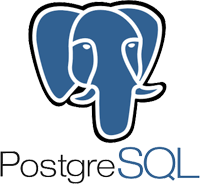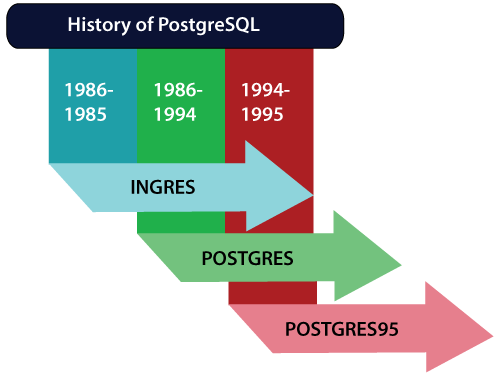PostgreSQL Tutorial
PostgreSQL is a popular relational database management system (RDBMS). Our PostgreSQL tutorial provides basic and advanced concepts of PostgreSQL. In this tutorial, we are going to learn all the topics of PostgreSQL language, such as create a database, drop a database, select database, select table, update a record, create a table, delete record, drop table, triggers, functions, insert the record, procedures, cursors, etc. We are also going to provide PostgreSQL interview questions and quizzes to help you better understand the PostgreSQL language. This tutorial will help us to understand all the primary features of PostgreSQL, also provides a knowledge on how to use PostgreSQL. What is PostgreSQL?PostgreSQL is an ORDBMS [Open-Source Object-Relational Database Management System]. It is used to store data securely; supporting best practices, and allow recovering them when the request is processed.
History of PostgreSQLPostgreSQL was developed by the PostgreSQL Global Development Group, which is led by a computer science professor named Michael Stonebraker at the University of California, Berkeley [UCB]. The professor's stonebreaker started in 1986 as a follow-up project and a post-Ingres project to overcome the problems of the existing database system. Initially, it was called as Postgres, but in 1996, the project was renamed to PostgreSQL. Then again, in 2007, they did some analysis, and the development team decided to preserve the name as PostgreSQL. And now, it is the most innovative open-source database available in the market. 
Note: In 1997, the first PostgreSQL release their designed version 6.0. And later on, the developers throughout the world will continue working on the software as the PostgreSQL Global Development Group. The development will continue creating the releases which are accessible for both open-source software and PostgreSQL License.PostgreSQL FeaturesIt is one of the most popular databases supporting JSON (non-relational) queries and SQL for (relational) queries. PostgreSQL is an object-relational database management system (ORDBMS). It contains the various advanced data types and robust feature sets, which increase the extensibility, reliability, and data integrity of the software. In this section, we are going to discuss the most advanced features, Database administration tools of PostgreSQL, and benefits and drawbacks, which will help us to enhance our knowledge of PostgreSQL. PostgreSQL includes multiple features that are designed to help the developers in developing the applications, manage our data in the datasets, and managers can keep the data integrity, and create the Risk-tolerant environments. Whenever the new release comes into the market, the PostgreSQL Global group of developers will enhance the previous features and adds some new features based on the user's demand. The essential features of PostgreSQL are as follows:
Note: Tcl is a general-purpose, high-level, dynamic, and interpreted programming language.
PostgreSQL Database AdministrationThe PostgreSQL database administration covers the essential PostgreSQL database server administration actions. We have several open-sources as well as paid tools available in the market. Let us understand some of the most commonly used database management tools of PostgreSQL: psqlIt is a terminal-based front-end command-line tool; where we can directly enter the SQL queries or run them from a file and we can also see the query results. It offers us many Meta commands and several shells, such as automate extensive ranges of tasks and facilitate writing the scripts. phpPgAdminIt is a web-based management tool for PostgreSQL and built on the phpMyAdmin interface, which was initially written for MySQL administration. The phpPgAdmin is written in PHP programming language. It can be configured easily and provides simple data manipulation. It keeps up the slony master-slave replication machine and also available in 27 languages. Here, we can import the SQL scripts and Copy the data. pgAdminIt is one of the most famous and open-source management and development platforms for PostgreSQL. PgAdmin is the most advanced database around the world. It can be used on various operating systems such as UNIX, Linux, Mac OS X, and Windows to achieve PostgreSQL 9.2 and above versions. PgFouineIt is a well-known query log analyzer for PostgreSQL, which is used to generate reports from the log files of PostgreSQL. It is accessible for RHEL (Red Hat Enterprise Linux) and CentOS Linux system through the EPEL (Extra Packages for Enterprise Linux) repositories. It is a PHP script, and it provides a moderate list of libraries. The pgFouine contains the older UNIX systems and the Windows as well. pgDevOpsIt is a suite of web tools that is installed and manages multiple PostgreSQL extensions and versions; it creates SQL queries and community components, monitors running databases, and identifies performance issues. It's a WSGI Python27 Flask application which can be executed on different cross-platform such as Windows, Linux, and OSX. It is an open-source application that can be used by various users on multiple servers. Note: Most of the organization recommends proprietary tools for PostgreSQL. Generally, it is an open-source tool, which is used to share administration features. On the other hand, it provides enhancements in data modeling, reporting importing, and exporting.Some of the commonly used Proprietary tools are as follows:
Advantages and disadvantages of PostgreSQLThe benefits of the PostgreSQL are as follows:
The drawbacks of PostgreSQL are as follows:
PostgreSQL IndexPostgreSQL Tutorial PostgreSQL Database PostgreSQL Table PostgreSQL Schema PostgreSQL Queries PostgreSQL Clause PostgreSQL Conditions
PostgreSQL Views PostgreSQL Join
PostgreSQL Advance Interview Questions PrerequisiteThe requirement to learn PostgreSQL is knowledge of the database, mainly the RDBMS and MySQL. It is database software having different settings and procedures. AudiencePostgreSQL tutorial provides basic and advanced ideas of SQL. Our PostgreSQL tutorial is designed for beginners and professionals. ProblemWe assure you that you will not find any difficulty while learning our PostgreSQL tutorial. But if there is any mistake in this tutorial, kindly post the problem or error in the contact form so that we can improve it.
Next TopicPostgreSQL Syntax
|
 For Videos Join Our Youtube Channel: Join Now
For Videos Join Our Youtube Channel: Join Now
Feedback
- Send your Feedback to [email protected]
Help Others, Please Share










